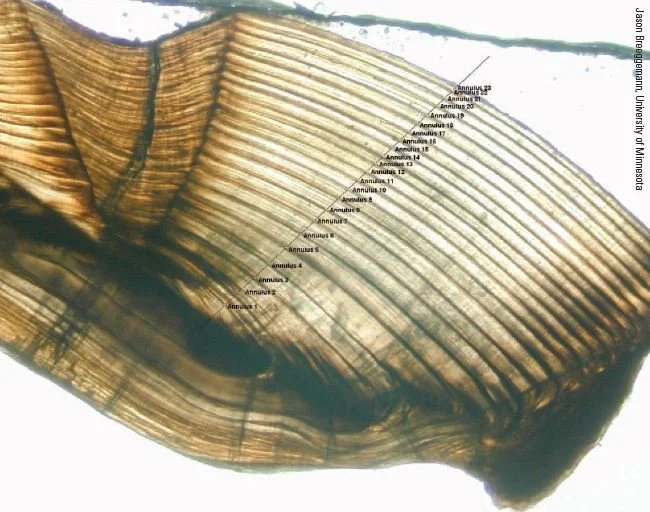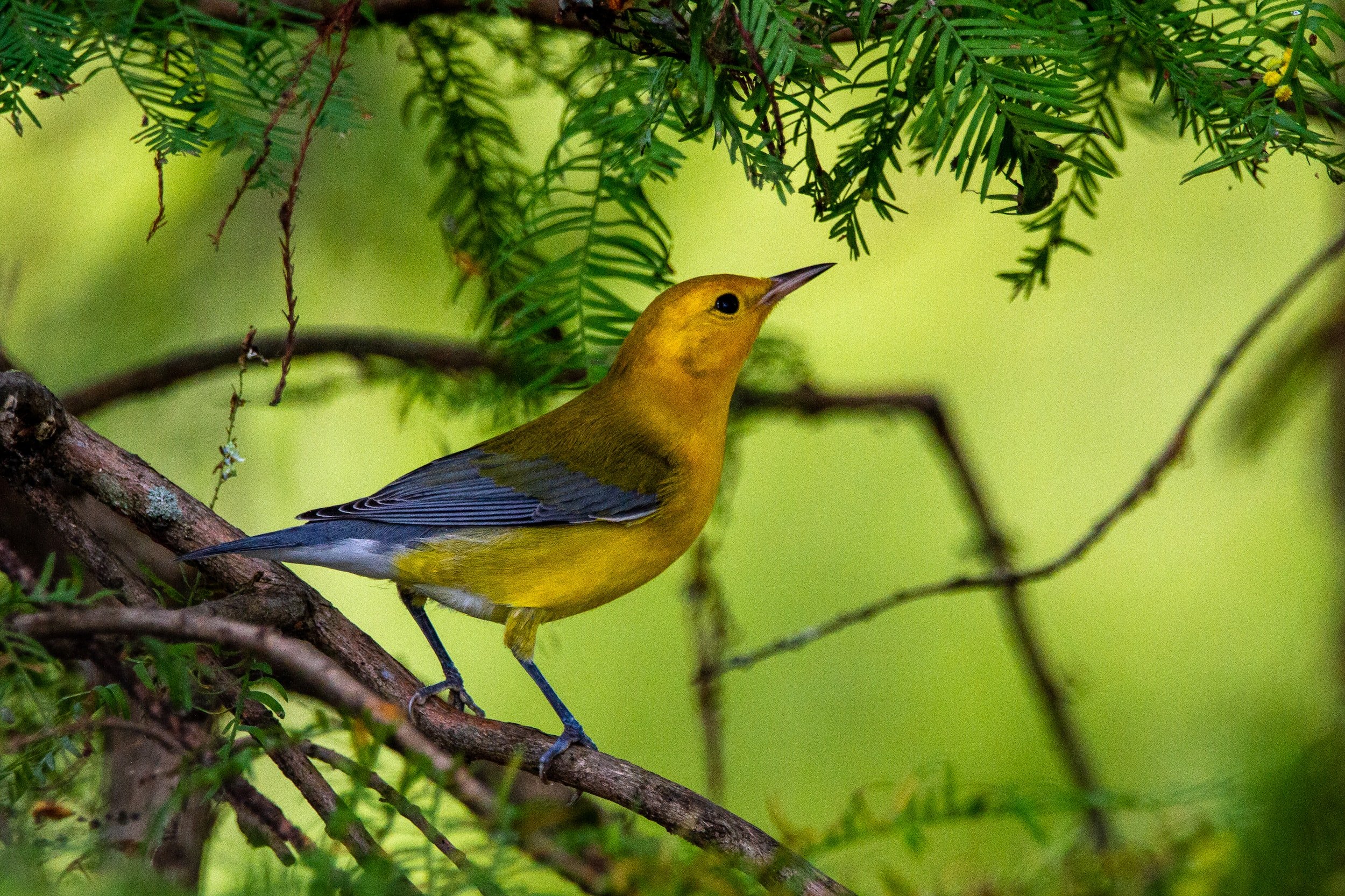The Ultimate Recycling
An essential part of keeping a Lake Erie port operating is dredging shipping lanes to maintain adequate depth for water traffic, whether that’s small fishing boats or large freighters. But what to do with the material that gets scooped up from the bottom of the lake? In many cases, it’s dumped in open lake waters, or impounded in lots near the harbor. But Dr. Elizabeth Dayton, Research Scientist at Ohio State University’s School of Environment & Natural Resources, believes the dredge material can be put to better use.

Listening in on a Fish’s Life History
On a typical fall day in Ohio, anglers line the banks of rivers like the Vermilion and the Conneaut, looking for that next great catch. Their main target is steelhead trout, a salmon relative native to the Pacific Northwest that has been introduced into Ohio, Pennsylvania, Michigan, and New York rivers to extend the recreational fishing season into the fall and early winter.
Dr. John Farver and Dr. Jeffrey Miner of Bowling Green State University are studying these fish, specifically their otoliths, a small bone that acts as a balancing organ and helps with hearing. Based on chemical elements incorporated into the otolith as the fish grows, the researchers are able to determine with better than 90% accuracy (100% accuracy for Ohio-stocked fish) the state hatchery in which the fish was raised, how much time the fish spent in the river once stocked, and potentially where in the lake it spent most of its life before returning to a stream to breed.
How’s the Lake Doing?
If you live on the shores of Lake Erie or any other body of water, you probably think about that environment’s health and how it can be improved or protected. But did you know that land management practices 50 or 100 miles away can still have an influence on the lake you see from your window? For example, land use and management near the Ohio-Indiana border, in the western reaches of the Maumee River watershed, can have an effect on the ecosystem of Maumee Bay halfway across the state.
Trying Out College Life
As a kid, Jack Gaskins spent many a summer at his family’s house on Middle Bass Island, enjoying the Lake Erie shore and venturing across to the other islands with his parents. Of course, South Bass was a frequent stop for meals, tours, and other adventures, so Stone Lab was a familiar sight at Put-in-Bay.

A Season of Impact
Stone Laboratory continues to build its reputation as an educational facility and as a research base, offering classes, workshops, and research space to 250 students and scientists from across the Great Lakes each year.
However, Ohio State’s Island Campus on Lake Erie also acts as Ohio Sea Grant’s outreach facility, where policy makers, journalists, and the public can learn about the lake’s role in the region’s economic and environmental health.

Strange Solutions
New materials like nanoparticles open up exciting opportunities for manufacturing companies, from construction supplies to medical innovations. But they also raise environmental concerns when they could enter rivers, streams, or the Great Lakes after their initial purpose is completed.
Dr. John Lenhart and Dr. Harold Walker of Ohio State University’s Department of Civil, Environmental, & Geodetic Engineering, along with graduate student Xuan Li, recently completed a project examining the fate of silver nanoparticles, often used in commercial products because silver acts as an effective antimicrobial agent. When those particles enter natural waters, such as rivers or a Great Lake, the silver can either aggregate (or clump together) and settle into the sediment, where it would affect bottom-dwelling organisms; or it can stay suspended in the water column, where it would slowly dissolve and release toxic silver ions into the water.
Fact-Checking the Forecast
Back in July, scientists from the National Oceanic & Atmospheric Administration’s National Centers for Coastal Ocean Science (NCCOS) issued the first-ever seasonal harmful algal bloom (HAB) forecast for western Lake Erie at a press event at Ohio State University’s Stone Laboratory. Now, with the 2012 HABs season over, Dr. Jeff Reutter reflects on the successful prediction and looks ahead to next year.

Improving Phosphorus Detection
Phosphorus is almost always at the forefront of concerns about the health of Lake Erie and its tributaries. Watershed managers never stop searching for ways to reduce phosphorus input into the ecosystem, but they also need to be able to monitor those nutrient levels easily and cost-effectively to report on their progress and address worsening conditions as soon as possible.

From Farm Fields to Wetlands
It’s a beautiful fall day on the Toussaint River, just south of the Ottawa National Wildlife Refuge on the Lake Erie shore. Along both riverbanks, farm fields attest to western Ohio’s agricultural roots, and on the water, the passengers of a metal boat, clad in heavy rubber waders, boots, and gloves, seem to be setting up for a mad science experiment.
OSU Climate Change Outreach Team Adds Local Context to a Changing Climate
Climate Change tends to pop into public conversation every few months or so, but for Ohio State University’s Climate Change Outreach Team, the topic has stayed relevant since the team’s inception in 2008. The group focuses on localizing climate change to Ohio and the Great Lakes region; by addressing the issue within a regional context, information becomes more relevant to planners, managers and citizens, making it more likely that they will act on new knowledge.
Supporting Students, Honoring Memories
Stone Lab students come from all walks of life, and while many of them spend their first summer on Gibraltar Island during high school or college, some don’t make it to the island until they’re adults. Even then, living and learning so close to Lake Erie can make a deep impression, and students often become vocal supporters of Ohio Sea Grant’s teaching and research programs at the Lab.
Lydia Bailey went one step further: after spending a few weeks at Stone Lab for undergraduate classes, she recognized the value of the program and wanted to make a lasting contribution.

Bitten by the Science Bug
The 5th graders watch intently as two of their fellow students pull in the trawling net. This is the moment they had been waiting for, the part of today’s trip they had begun asking about two hours earlier. The students crowd around the metal basin holding their catch, touching the slippery fish, yelling when one of the fish jumps, and taking photos with their phones.
It’s pretty difficult for an indoor class to match this level of excitement.
“This is one of those Stone Lab experiences that I can’t replicate in the classroom,” says their teacher, Robin Sneed.
Summer Workshops Introduce Teachers to Great Lakes Climate Change Curriculum
For teachers interested in adding regional climate knowledge to their lesson plans, Ohio Sea Grant and the Ohio State Climate Change Outreach Team are now offering an additional resource. An updated Great Lakes Climate Change Curriculum, focusing on regional changes and effects, was introduced at teacher workshops in Ohio this summer, and parts are already available at changingclimate.osu.edu.
The workshops, held at the Lake Erie Nature & Science Center in Bay Village and at the University of Toledo’s Lake Erie Center in Oregon, gave 27 teachers and informal educators a chance to preview a selection of activities from the new curriculum, both in the classroom and in outdoor demonstrations. They learned about simulating maple tree migration and the effects of carbon dioxide on global temperatures, and completed some of the written exercises they will later assign in their own classroom.

The Malevolent Seven
Lake Erie has seen some difficult times. Considered the poster child of water pollution in the 1960s, with one tributary so polluted it burned, many thought of it as dead. But Lake Erie recovered, thanks to comprehensive phosphorus restrictions and inter-agency collaborations, and turned into an impressive success story of what ecosystem recovery efforts can accomplish in just a few years. The lake became a major economic player once again, producing more fish than the other four Great Lakes combined, supporting thousands of jobs, and showing nay-sayers just how resilient it can be.
But over the last ten years, Lake Erie has had to do battle once again. And it’s a battle many fear could seriously challenge its resiliency.
Is Nitrogen Another Concern For Lake Erie?
Phosphorus: It’s what most people think about when conversations turn to harmful algal blooms (HABs) in Lake Erie. However, it’s not necessarily the only nutrient influencing algal growth in the lake. A new Ohio Sea Grant-funded research project at Kent State University is investigating the role nitrogen plays in supporting the growth of cyanobacteria—more commonly called blue-green algae and a frequent culprit in HAB events.
Dr. Darren Bade, Assistant Professor of Biological Sciences at Kent State, will examine the effects of nitrogen, a common nutrient found in fertilizers as well as animal waste, on the growth of cyanobacteria.
Climate-Proofing Science Education in the Great Lakes
Climate change is becoming a challenge for individuals, communities, and countries across the world. But the Great Lakes ecosystem will face its own set of trials (and advantages) as the local climate shifts along with the global. And while community managers, policy makers and public health officials are dealing with the effects of climate change on the region, teachers are looking for materials they can use to teach the next generation of Great Lakes residents about a changing climate.
The Swamp in OSU’s Backyard
When the climate change conversation turns to storing carbon emissions in plant materials, people tend to think about forests and other large, often woody plants. But some researchers have found that wetlands, which are often more commonly known as marshes and swamps, may be much more effective in storing atmospheric carbon in its inactive forms.

Modeling the Shores of Lake Erie
Computer modeling has become an important part of everyday life, from creating weather forecasts to deciding where to put a new traffic light. And, as with all models, the accuracy of their predictions depends on being able to feed them accurate information. This includes the initial information used to create the model, as well as any adjustments as measuring and modeling technologies improve over time.
Dr. Ethan Kubatko, from Ohio State University’s Department of Civil & Environmental Engineering & Geodetic Sciences, is working on such an adjustment to the Lake Erie Operational Forecast System (LEOFS) model, which visualizes the flow of water throughout Lake Erie. When Kubatko joined OSU in 2008, he came across a report of how the model had been performing and noticed a pattern to the data.
Lake Erie From Above… Way Above
Everyone who lives on the shores of Lake Erie has probably seen an algal bloom—sheets of green or blue-green algae covering the water’s surface, sometimes accompanied by a foul odor of rotten eggs that can severely impact water quality. In a best-case scenario, such algal blooms lead to unpleasant weekends at the beach, but worst-case scenarios can range from fish kills to liver damage due to the toxins some algae release. These potential difficulties make effective monitoring systems an important research priority.

Of Birds and Trees and Climate Change
Climate change is not only likely to affect our weather, our water levels, and our health, but also the variety of birds we see in our backyards and city parks. Changing environmental conditions will affect where these birds live, raise their offspring, and spend their winters, and wildlife managers across the Great Lakes region and beyond will have to consider these potential changes when deciding on the best way to manage the wooded areas in their care.